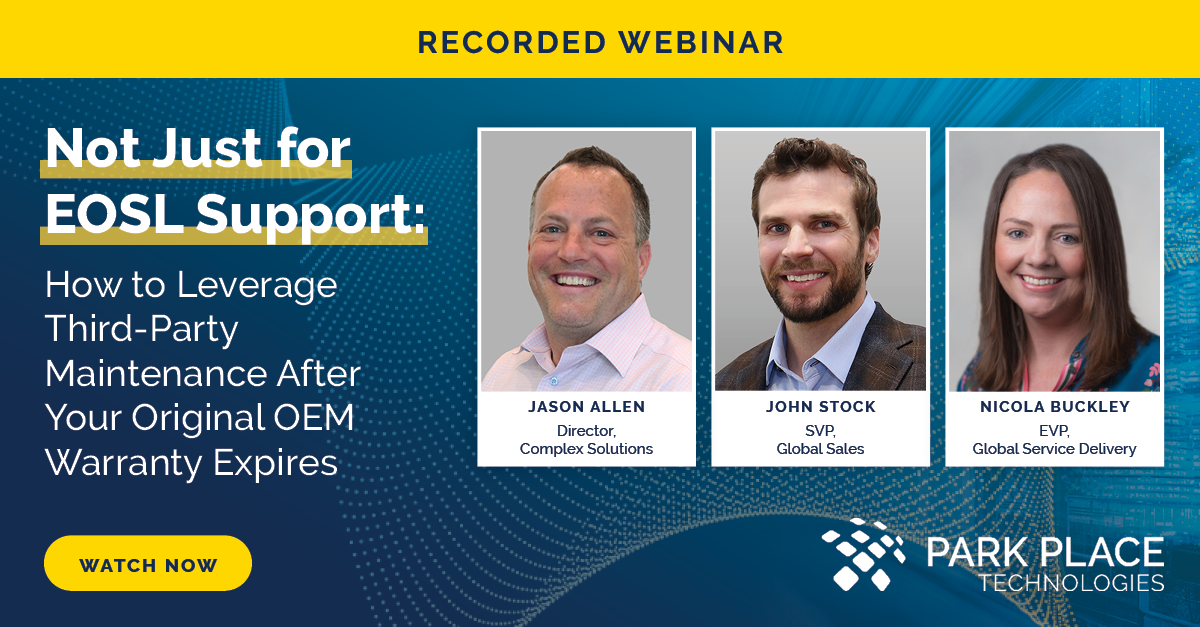3 reasons to extend hardware life cycles
Park Place Hardware Maintenance
A good hardware maintenance plan can enable IT managers to maximize the value of their infrastructure by avoiding an unnecessary refresh. However, successfully extending hardware life cycles can also create considerable risk if IT teams are unable to establish an effective maintenance strategy to protect against outages and ensure a rapid response if any components fail. This risk may lead some to wonder why IT managers would bother dealing with legacy systems.
There are many answers to that concern, as legacy hardware creates value in a variety of ways. Having a third-party hardware maintenance plan in place is key to leveraging this value effectively, but a few key issues stand out in terms of getting value from legacy systems:
1. Eliminating unnecessary capital costs
Making a premature hardware refresh can put an incredible strain on a business’ capital expenditures. In many cases, an OEM will make an end-of-service-life announcement and stop supporting hardware after a number of years. This can prove incredibly disruptive for IT managers if that hardware is still meeting operational demands. Furthermore, extended warranties from the OEM can be incredibly expensive. As such, many organizations end up turning to a hardware refresh to avoid the operational expense. Implementing a third-party hardware maintenance plan can extend life cycles beyond the EOSL date and enable IT managers to avoid the costs that come with an expensive extended warranty.
2. Take advantage of niche solutions
The commoditization of the hardware sector has created an operational climate in which it can be very difficult for organizations to find specialized solutions that meet specific operational needs. IT managers using legacy systems that meet a niche requirement, such as storage solutions that feature built-in redundancy, can be invaluable for IT leaders trying to establish a robust, efficient and sophisticated configuration.
The problem with many OEM warranty plans is that the service model focuses on driving sales of new hardware. The support may be of a high quality, but OEMs emphasize sales as their core competency. Third-party hardware maintenance providers, on the other hand, focus on supporting legacy systems as their primary competency. This results in a cost-efficient service plan that enables IT leaders to hang on to particularly effective niche solutions well beyond the EOSL date without taking on fiscal or operational risk.
3. Avoid unnecessary disruption
Sometimes IT managers can be left feeling like all they do is solve problems every day and never end up getting to build on a foundation of success. This often happens because technology and business requirements change so fast that IT teams are often playing catch up to solve problems, install new systems and manage infrastructure. Frequent hardware refreshes are a major contributor to this problem. Migrating data from an older system to a new one is incredibly disruptive and takes a great deal of time and money.
IT managers that want to get ahead of the curve and start taking a proactive approach to managing infrastructure often benefit from strategies that give them more control and allow them to avoid completing unnecessary operations. Extending hardware life cycles fits what IT managers need to stay ahead since using a perfectly functional infrastructure beyond its initial warranty eliminates the disruption caused by hardware refresh. IT teams are then able to focus operations in other areas. A third-party hardware maintenance plan is often key in this area, however, as the solution keeps costs under control, allowing IT to take on aggressive legacy hardware strategies.
IT managers are facing incredible pressure trying to balance a variety of services while staying within the budget. Extending hardware life cycles through effective hardware maintenance and operating system support plans can alleviate the burden.



